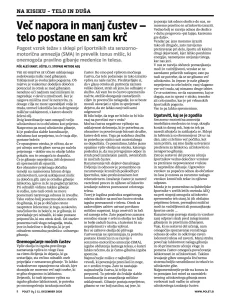The source article can be found by pressing the button on the bottom of the screen.
Nasal breathing moisturizes and heats the air, prevents the drying of the mucous membrane, removes many pathogens, and raises nitric oxide in one’s blood.
Competition is not a time for an athlete to focus on how well he breathes, but he should be completely focused on the competition.
After training and less difficult exercises or other regular activities, you should breathe through your nose.
Athletes who are determined to beat competitors or engage in sports to satisfy a desire for prestige or calm internal tensions will do whatever it takes to win. They will change with even more difficult training, the results of which are uncomfortable or painful body sensations.
The balance between exercise and training will collapse, and the increase in effort will not be coordinated with the increase in movement efficiency. Due to his belief that pain is the confirmation of sufficient effort and determination, to the athlete, it doesn’t represent a warning on his approach’s inappropriateness, but a confirmation that he is on the correct path.
When he observes others, he sees that they also act in this manner, and it reinforces his belief that this is normal, so he doesn’t change his approach. The consequences in the form of chronic pain, wear, and recurring injuries are treated as a part of sports – even though the sport is supposed to be a healthy mind in a healthy body.
He accepts this only in principle, as the superego needs to achieve the impossible and thus proves that it is capable, too great, and the body’s influence on the mind too small.
The role of bodily consciousness
Athletes regularly use AEQ breathing to improve their abilities and raise their consciousness and their inner connection. When they balance exercise, training, and rest, they become focused enough to avoid any, if not all, inconveniences. And will most likely achieve their desired result or goal.
Breathing is very important for correct development. The appropriate understanding of physiological and chemic processes that allow for breathing is just as important as knowing the best diet or technique and rules of a sport that we wish to master. Breathing is a movement. Therefore, its quality and suitability are determined by the coordination of muscle tone changes of primary and secondary respiratory muscles and the ability to be aware of the current breathing mode and airflow coordination through the respiratory system with current motor effort.
That’s how an athlete, to achieve better results with less unnecessary effort and pain as a constant escort becomes better in controlling his breathing and acting holistically. By breathing, he can adequately prepare for the lifting of the load, responsibility, or calm down faster after the end of the effort and thus better prepare for the next one.
The point of this approach is to increase the role of the bodily consciousness, which consequently eliminates unnecessary surviving conditions and survival responses, allows for a change of approach and more frequent relaxed movement even under loads.
The feelings of discomfort, pain, and comfort define the relationships between loads, the need to achieve the desired goal, physical performance, and motor intelligence/knowledge/organic organization.
Three paths – which one will you chose?
If the physical load is above capacity and motor intelligence, the disorder increases, and we feel an ever-increasing pain that points to an even – stronger and more harmful entropy. If we stubbornly insist on overcoming ourselves and passing our limits, the disorder leads to injuries and wear. At such a load, we always breathe through our mouths.
Suppose the physical load is smaller than our abilities but is higher than our motor intelligence/knowledge/organic organization. In that case, we feel effort, discomfort, and fatigue, which we describe as “we can do it.” Breathing is mixed (especially if we don’t know the meaning of nasal breathing), inhale is through the mouth, exhale through the nose, or exercise great control to maintain full nasal breathing.
If the physical load is within our capacity or the difficulty is lower than our current motor intelligence/knowledge/organic organization, we feel the movement as pleasant, light, playful. We describe the feeling as “we know.” We feel control over the action, mastery, and pleasure. Our breathing is nasal and effortless.
The nose performs at least 30 functions, all of which are important and complement the lungs, heart, and other organs.
If we wish to achieve top results, we have to increase our motor intelligence, knowledge, and organic organization, the interweaving of all will help us raise our efficiency. Only then can we focus on raising the workload.
We can raise our motor intelligence with AEQ exercises and a conscious approach to exercise, work, and movement when possible. We go to extreme lengths in testing, competition, or in circumstances where survival is at stake. This system allows obtaining mastery of certain areas and getting closer to our highest genetically set abilities. This approach requires significantly more time, knowledge, and reason than the approach through effort and pain, which allows for rapid progress, but with a very limited and increasingly difficult to reach.
It is similar to trying to learn how to drive a car using only in first gear. The system applies to all life areas—emotions, interpersonal relationships, business operations, financial situation, schooling, and elsewhere. By analyzing the results, feelings, and well-being, we can see where we are, how we approach fulfilling desires and duties, and correct what is necessary for better efficiency.
If we wish to achieve top results, we have to increase our motor intelligence, knowledge, and organic organization, the interweaving of all will help us raise our efficiency. Only then can we focus on raising the workload.
Our nose is a multitasker
“The nose performs at least 30 functions, all of which are important and complement the role of the lungs, heart and other organs.”, says dr. Maurice Cottle, the founder of the American rhinological club. The nasal cavity plays a vital part in the philosophy of breathing. It encourages filtration, moisturizing, and heating inhaled air. This makes the air that enters the body have the perfect temperature and thus supplies the body with oxygen.
Nasal breathing while awake represents half as much resistance to airflow than breathing through the mouth. The result is a fifth higher oxygen intake due to higher CO2 levels in the blood. Nasal breathing moisturizes and heats the air, prevents the drying of the mucous membrane, removes many pathogens, and raises nitric oxide in one’s blood.
After exercise, less difficult tasks, and other ordinary activities, always breathe through the nose. An appropriate ratio in endurance sports is 80 percent of the movement with the mouth closed and regular work to increase respiratory arrest. Respiratory arrest is the time between a finished exhale and the first feeling of needing to inhale.
Up to 20 percent, however, perform high-intensity interval training while breathing through your mouth. You only do these when you feel strong when you feel good about your body and want such workouts.
This ratio also depends on the athlete’s psychophysical condition, the sport he participates in, and the current season.
During the competition, with proper preparation, there is no need for deep breaths, nor is there a need to deliberately hold these. If we regularly breathe incorrectly, it clearly shows that we are not yet prepared to face the competition or the competitors’ difficulty, and the chance of injury is larger.
It’s important to maintain a relaxed feeling in the body and to breathe to satisfy the need. If this is not possible, the regulation of respiration should take precedence.
Competition isn’t the right time for an athlete to focus on how good or bad his breathing is. Instead, he should be completely focused on the competition. That’s why breathing exercises should be daily, where lower muscle rigidity is key because it allows for longer respiratory arrest.
Amateur athletes who do not participate in competitions and do not perform heavier exercises have an easier task in the general maintenance of nasal breathing, although they usually breathe the worst, mainly because they engage in sports to remove nervousness and tension from themselves.
Good intentions but a bad attitude towards the body
If we do sports to rid ourselves of nervousness and tension, then it’s a very bad and harmful reason since it doesn’t lead to a rise in efficiency, but to a hateful attitude to the body where the feeling we want to get rid of is located.
The analysis of motives and previous influences of sport on physical and mental well-being enables insights into the need to introduce changes that will enable harmless progress and satisfaction.
Everyone prefers to drive with a shifting driver who gets to the finish line sooner and safer; the possibility of an accident is much smaller. The destination path will remain in our memories better than if we were driving with someone who has trouble driving.



